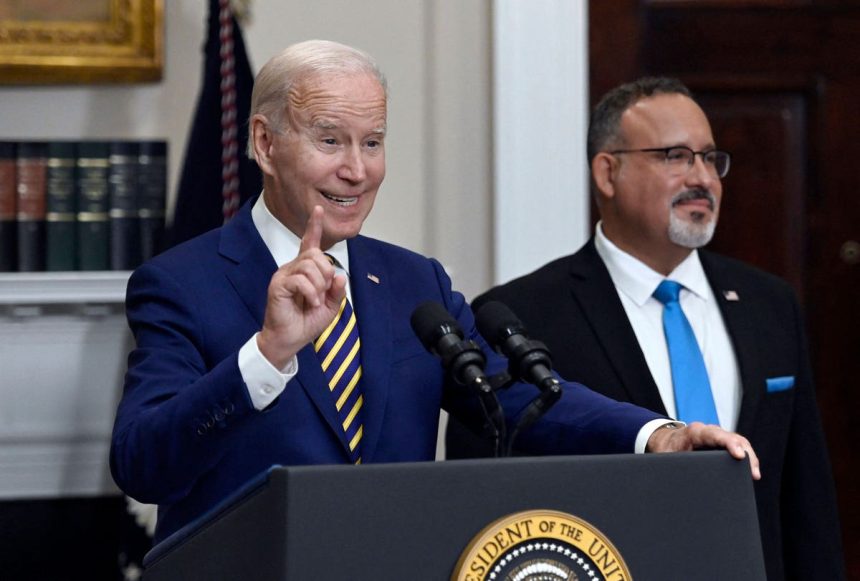Last month, the Supreme Court struck down President Biden’s attempt to unilaterally cancel up to $20,000 in federal student loans for most borrowers. The high court ruled that decisions of major economic significance, such as the $430 billion loan-cancellation scheme—rest with Congress rather than the executive branch. While the Biden administration will abide by the ruling, it is not taking the spirit of the Court’s decision to heart.
Instead, the administration has set in motion several other programs to cancel debts or reduce payments through executive action. These include, in rough order of immediate relevance for borrowers and taxpayers:
- A one-time waiver that will move millions of borrowers closer to loan cancellation under income-driven repayment (IDR); this waiver recently resulted in the immediate cancellation of $39 billion in debts.
- A twelve-month “on-ramp” beginning when student loan payments resume this fall after a three-year hiatus, during which borrowers will not face negative consequences for missing payments.
- A new income-driven repayment plan which will cut loan payments by more than half for undergraduate borrowers, at a cost of $276 billion over ten years.
- A second attempt at mass cancellation of student loans using a different purported legal authority than the administration’s first attempt, which the Supreme Court struck down.
One-time IDR waiver
On Friday, the Education Department announced that 804,000 borrowers would receive loan cancellation totaling $39 billion. This is the result of the so-called “one-time IDR waiver” announced last April. Normally, borrowers enrolled in an income-driven repayment plan must make 20 or 25 years’ worth of qualifying payments in order to receive loan cancellation. The waiver, however, will allow borrowers to count months in which they made payments in a non-IDR plan towards that 20- or 25-year quota. Borrowers will even be allowed to count certain periods in which they were not making payments at all.
The result is that hundreds of thousands of borrowers who were several years short of the 20- or 25-year mark will automatically be moved across it, resulting in $39 billion of immediate loan cancellation. But that $39 billion figure is an underestimate of how much will be forgiven through this policy. Millions of other borrowers will move several years closer to the 20- or 25-year threshold, even if they have not crossed it yet. The result will be a significant uptick in loan cancellation over the coming years as more borrowers move across the threshold.
Advocates of the waiver contend that the Education Department and loan servicers improperly counted qualifying IDR payments in the past, meaning the waiver is necessary to make those borrowers whole. But the waiver is overly broad for this purpose. Many borrowers who never enrolled in an IDR plan and never sought to will still qualify. Among the groups poised to benefit are those who took out large loans for professional school prior to the expansion of IDR and have repaid them on a graduated or extended (non-IDR) plan. This group, which includes plenty of doctors and lawyers and others who don’t need handouts from the federal government, will essentially get their last five to ten years of scheduled loan payments wiped away.
Twelve-month repayment on-ramp
Student loan payments have been paused since March 2020, with no interest accumulating. While Congress authorized an initial six-month pause on payments in response to the Covid-19 pandemic, the Trump and Biden administrations extended the pause several times through executive action. Finally, as part of the budget deal that Congress and the administration agreed to in June, the Education Department will be required to resume loan payments in September. Theoretically, that should bring an end to the pause, which costs taxpayers $60 billion per year.
The return to repayment is bound to be tricky, as most borrowers have not made a single payment on their loans in over three years. Some have never paid at all, and millions have new loan servicers and thus new points of contact in the student loan system. The Biden administration will use this as justification to enact a 12-month “on-ramp” for borrowers returning to repayment. For the first 12 months after payments resume, interest will accumulate and payments will be due, but borrowers who miss payments will not enter default, nor have their credit reports impacted.
A shorter transition period makes sense; the Education Department had originally planned for a 90-day “grace period” for missed payments. The 12-month on-ramp, however, was announced only after the Supreme Court handed down its ruling nullifying the loan cancellation plan. That suggests a political motivation for the sudden quadrupling of the on-ramp period. The danger is that administration may use the on-ramp as a substitute for the payment pause, to be extended by the Education Department at will in order to mollify borrowers angry that loan cancellation did not go forward.
New IDR plan
In addition to the one-time IDR waiver, the Biden administration will also make income-driven plans far more generous going forward. The most generous current iteration of IDR sets student loan payments at 10% of a borrower’s income above 150% of the federal poverty line, with remaining balances forgiven after 20 years. The newest IDR plan, dubbed the “SAVE” plan, will cut that to just 5% of income above 225% of the poverty line for undergraduate borrowers, with remaining balances forgiven in as little as 10 years.
The Department also announced that it would push forward the effective date of the most costly provisions of the plan. The portion of income exempt from payments will rise from 150% to 225% of the federal poverty line immediately, while most of the other provisions will take effect next summer.
The Congressional Budget Office has previously estimated that the new plan will cost taxpayers $276 billion over ten years. But the more pernicious impact of the rule is its effect on the incentive structure in higher education. As I wrote at OppBlog:
“The proposal slashes payments for undergraduate borrowers so much that many will repay only a fraction of what they borrowed. The Urban Institute estimates that just 22 percent of four-year college graduates and 11 percent of two-year college graduates will repay their loans in full. In particular, graduates of programs with a negative return on investment will get large subsidies. More students will find it rational to borrow from the federal government, particularly if they enroll in low-return programs. This will encourage colleges to hike tuition and expand programs of questionable value.”
In the long run, the moral hazard effects of the new IDR plan will be more consequential than the one-time student loan forgiveness which the Supreme Court struck down. After all, the new plan will apply to the $1 trillion in new student loans that the federal government originates every decade, not just existing loans as the loan-cancellation scheme did.
Second attempt at mass loan cancellation
After the Court handed down that decision, the administration wasted no time announcing that it would try to enact its loan-cancellation ambitions through a second legal authority. The original scheme relied on the 2003 HEROES Act for its purported authority; the new plan relies on the 1965 Higher Education Act (HEA). As I’ve written before, the legal authority to forgive debts en masse through the HEA is dubious. The Court’s broad ruling in the first loan-cancellation case leaves little doubt it would strike down this second attempt as well.
But the administration intends to try. The catch this time around is that the HEA requires the Department of Education to go through a formal rulemaking process in order to cancel any debts. That will require a public hearing (scheduled for tomorrow, July 18), a negotiated rulemaking session, a proposed rule, a public comment period, and a final rule. All that must come before the almost-certain lawsuits, which will add further delays.
While the end result will be the same—this second loan cancellation attempt will fail as did the first—the process will drag out through the 2024 elections and possibly beyond. That will allow President Biden to run for reelection as the debt forgiveness candidate. But beyond that, the second attempt at loan cancellation will be a waste of everyone’s time. Moreover, it may undermine the return to repayment in the fall, as borrowers may refuse to make payments on their debts if they can hold out hope for forgiveness. Any hope, however, will be a false one.
Biden should work with Congress on student loan relief
Mass loan cancellation is a nonstarter in the Republican-controlled House of Representatives. But Republicans have put other proposals on the table to help borrowers who make a good-faith effort to repay their loans get out of debt. Rather than going it alone on student loan policy—changes through executive order are vulnerable to lawsuits and may be reversed by future administrations—President Biden should work with Congress to deliver lasting reforms to the federal student loan program.
Read the full article here










